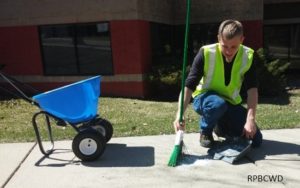Lawn Care: How To Fertilize Responsibly
Fertilizer can be a useful tool when growing tall, healthy plants, but too much fertilizer can cause problems for water quality and surrounding wildlife. It is important to follow the recommended ratio of fertilizer to lawn area that is listed in your fertilizer’s instructions. This recommendation will depend on the percentage of nitrogen your fertilizer contains. A healthy guideline is to apply no more than 0.9lbs of nitrogen per 1,000 square feet of area. Exceeding the recommended application amount can pollute nearby waterbodies, because too much nutrients can lead to harmful algal blooms. If you notice excess fertilizer that landed on your driveway or the street, it is important to sweep the fertilizer back into your yard to prevent the spread of fertilizer to nearby waterbodies.

Not only can too much fertilizer be harmful, but fertilizers that contain phosphorus are dangerous pollutants to nearby water. Phosphorous is a hazardous pollutant, so Minnesota made it illegal to use phosphorous-containing fertilizers on standard lawns. Phosphorous-containing fertilizers may only be used on establishing turf or on soil that has been tested and shown a need for phosphorous. The danger from using too much fertilizer or phosphorus-containing fertilizer occurs when rain carries excess fertilizer to a storm drain. The fertilizer-containing water then flows to the nearest body of water without being cleaned or treated. Waterbodies with too much nutrients are much more likely to develop unwanted algal blooms which have an unpleasant smell and appearance.
For more information on organic lawn care, visit: Clean Water MN
For more fun facts on conservation, visit: https://www.ninemilecreek.org/trivia/
